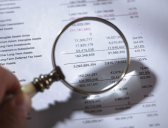Not keeping track of your balance sheet is one of the quickest ways to doom your business. You need to know whether you can make debt payments, if you have too much inventory, and even how much your customers owe you.
The first step to reading a balance sheet is understanding the difference between assets and liabilities.
What is an asset?
On your financial statement, business assets are all items of value that you purchased in a transaction. This means that wishy-washy things leadership trainers may say, such as, “Your employees are your greatest asset,” don’t fly for accountants.
Accountants like numbers and need to track everything back to a transaction. You may pay your employee, but that pay is expensed, not capitalized. When a purchase transaction is expensed, it goes on the income statement. When it is capitalized, it goes on the balance sheet as an asset.
Typically, you expense single-use or super low-priced items, and you capitalize bigger items that will be used over a longer period.
You can also create assets with credit sales. When you sell something on account, you create an accounts receivable (AR) that is an asset on your balance sheet. Additionally, if you prepay for a year’s worth of rent, you would show that as an asset on your balance sheet.
Types of assets
Here are the main types of assets.
1. Short-term
Short-term assets will be converted into cash in less than a year. Below is a list of assets that are normally considered short-term:
| Cash | This is the cash in your bank accounts net of all outstanding checks. |
| Inventory | Inventory is the items you will sell. Inventory is usually made up of raw materials, work in progress, and finished goods. |
| Accounts Receivable (ARs) | ARs are the amount that your customers owe you from credit sales. |
| Prepaid Expenses | Whenever you prepay for expenses ahead of time, an asset is booked so that the expenses show up on the income statement at the correct time. |
2. Long-term
Long-term assets may be converted to cash in less than a year, but the intention is for them to remain with the company for longer. Most long-term assets are depreciated. When the asset is purchased, the cost does not show up on the income statement.
Instead, an annual depreciation charge is taken from the asset so that the expenses match the timing of the income statement. If you use a building for 20 years, you don’t want to expense it all at once.
Here is a list of long-term assets:
| Property | Property is the land that buildings are built on. Unlike other long-term assets, land is not depreciated. |
| Plants/Buildings | Buildings are usually depreciated on a 30-year basis. |
| Equipment | Equipment can include diverse items such as computers, vehicles, and even massive factory machines. Depreciation timing depends on the useful life of the individual items. |
| Notes Receivable | Notes receivable are long-term loans made to other businesses. |
3. Contra
There are two main contra assets: accumulated depreciation and allowance for doubtful accounts. Contra accounts are considered assets, but they reduce the net amount of the main asset that they are related to.
Accumulated depreciation is the total amount of depreciation that has been charged off of the asset. Allowance for doubtful accounts is the ARs that you have written off because you don’t believe they will ever be paid.
4. Intangible
Remember when I said that accountants can’t handle wishy-washy definitions of asset? Well, that’s mostly true.
If you were to stick to accounting only, every business would be worth just the value of its assets minus all liabilities. But that is not how the world works. Many businesses have such great brand power or even — gasp! — such great employee talent and culture, that the value of the whole business is far more than simply the value of the assets.
When one business purchases another and pays more than the cost of net assets, the difference is added to the purchasing company’s balance sheet as goodwill, which is an intangible asset.
There are other assets, such as patents, where the cost of filing the patent is capitalized on to the balance sheet. Patents are amortized over the period of years that they will remain valid.
What is a liability?
Liabilities are claims on assets. Sometimes they are a direct claim on an asset, such as a bank loan taken out to buy a building. Other times, a company will book a liability when it has incurred the expense.
Types of liabilities
Business liabilities aren’t as numerous as assets. Let’s take a look at the types of liabilities.
1. Short-term
The two main short-term liabilities are accounts payable (AP) and accrued expenses. Accounts payable are incurred when you purchase a product or service on account. Normal terms will give you the opportunity to pay in 30 days. Some construction companies may only pay when they’re paid, so APs could take longer than 30 days to pay off.
Accrued liabilities are other balance sheet liabilities that must be paid but don’t have a direct invoice. For example, on my company’s balance sheet I have accrued liabilities for items such as employee tax withholding that is withheld from paychecks weekly but only paid to the government quarterly. I’ll also calculate accrued sick and vacation time based on all of our employees’ current balances and their pay rates.
2. Long-term
For most small businesses, the only long-term liabilities will be term loans from banks. This would include everything from a three-year loan for a trailer to a 20-year loan for a building.
Assets vs. liabilities: What’s the difference?
We should start by talking about the accounting equation. This equation was drilled into my head for a couple of years when I started my accounting major. Then, when I was a teaching assistant, I drilled it into many other students’ heads.
Assets = Liabilities + Equity
All accounting statements can be traced back to individual transactions, and every transaction has to balance. Assets are balanced with liabilities and equity. Liabilities are other people’s claims on your assets, and equity in accounting is your claims on your assets.
Here are a few sample journal entries (done the same way they would be in your accounting software) showing assets transactions.
| Equipment | $10,000 |
| Cash | $10,000 |
| Inventory | $1,000 |
| Accounts Payable | $1,000 |
| Accounts Receivable | $5,000 |
| Revenue | $5,000 |
Let’s go over each of these transactions. The first is an asset-for-asset transaction where you buy $10,000 worth of equipment with cash, so the equipment balance goes up and the cash balance goes down.
The second is an assets-for-liability transaction. You buy inventory on account, so your inventory balance goes up, but you need to pay the invoice, so your liabilities go up as well.
In the final transaction, you make a credit sale to a customer. Your accounts receivable go up, showing the customer owes you money, and the sales account goes up. Sales and all other income statement accounts are equity accounts, so equity goes up to balance with assets.
Examples of assets vs. liabilities
Here are a couple of examples of how assets and liabilities interact.
1. Inventory vs. payables
For many businesses, especially retail, accounts payable are associated mostly with inventory. You buy inventory on account and then pay it off either when it sells or within 30 to 60 days.
In the initial transaction, you increase both inventory and payables, but from then on the two are split, and it is up to you to decide how and when to sell the inventory and pay off the payables.
2. Buildings vs. long-term debt
Almost all buildings are financed by long-term debt. That’s because it makes sense. It allows your business to grow because you have a bigger space and don’t have to dish out the entire purchase in cash.
Like the first example, the two are split once the initial transaction is done, with loan payments often being made automatically. However, if the building is sold before the loan is paid off, the proceeds will pay down the rest of the debt.
Keep it balanced
You can’t manage a business without measuring your success, and the first step to being able to measure success is knowing how to read financial statements. Over time, you’ll be able to see how every transaction impacts the whole business and start to increase equity claims on assets relative to liabilities.
The post What Are Different Types of Assets and Liabilities? appeared first on The blueprint and is written by Mike Price
Original source: The blueprint






